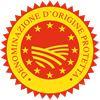Description
The Queijo do Pico PDO is a mature cheese made from cow's milk and coagulated with natural rennet. It has a fat content of between 45% and 49% and 67% to 71% humidity.
Production Area
Queijo do Pico PDO cheese is made on the island of Pico, in the Azores.
Production Method
The milk, from traditionally reared and fed cows, is filtered and stabilised at a temperature of 26°C to 27°C. The rennet is salted and diluted with water before it is added to the milk. Coagulation takes between 45 and 60 minutes. The curd is cut into small cubes with a spatula and then placed in a muslin cloth to drain the whey. The remaining paste is placed in the moulds and hand pressed. The cheeses are dry salted (about 21 gr) on each side. The moulds are left over night and then placed in the finishing room where the temperature is kept at between 15°C and 17°C and the humidity at 75% to 85%, for a period of 17 to 30 days.
Appearance and Flavour
Queijo do Pico PDO cheese has a very flat, squashed, cylindrical and very regular shape with rounded edges and a diameter of 16 cm to 17 cm, a thickness of 2 cm to 3 cm and a weight of between 650 gr and 800 gr. The rind is yellow but the cheese is white, with a soft consistency, pasty and very buttery and with regular air bubbles. It has a rich and salty taste and an intense and pleasant aroma.
History
The history of Queijo do Pico PDO cheese is closely linked to the history of the island. The island has the perfect conditions for rearing livestock for milk, which in fact is one of the pillars of a fragile local economy. The harsh climate and the difficulty of transport have influenced the amount of cheese that is made here, since it is a reserve source of low cost nourishment and the only way of preserving the milk. The first official written references to be found to Queijo do Pico PDO date back to 1867 and 1877 when the importance of cheese making on the island was recorded.
Gastronomy
Queijo do Pico PDO cheese must be stored at a temperature of between 0°C and 12°C. It can be eaten with an aperitif or at the end of a meal or with a glass of the local wine, Verdelho do Pico wine.
Marketing
This cheese is sold as Queijo do Pico PDO. It is sold loose clearly labelled, bearing a seal of guarantee and its PDO certification.
Distinctive Features
The quality of Queijo do Pico PDO is owed to the production method and the method of rearing the cattle on this island, which are both carried out, still today, in the purely traditional manner. This is because of the many years of the relative isolation of the inhabitants of the island which has also led to the conservation of the traditional techniques of cheese making.







